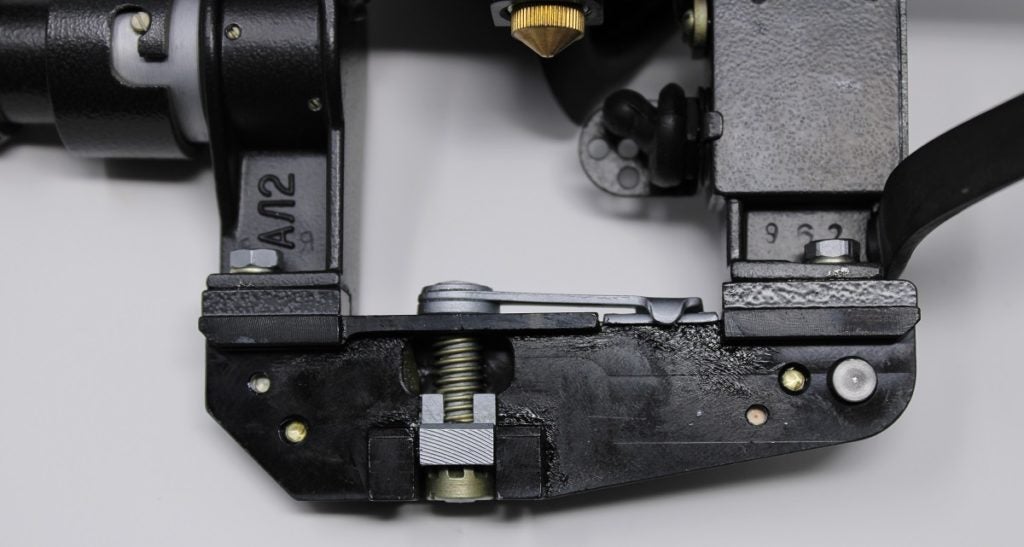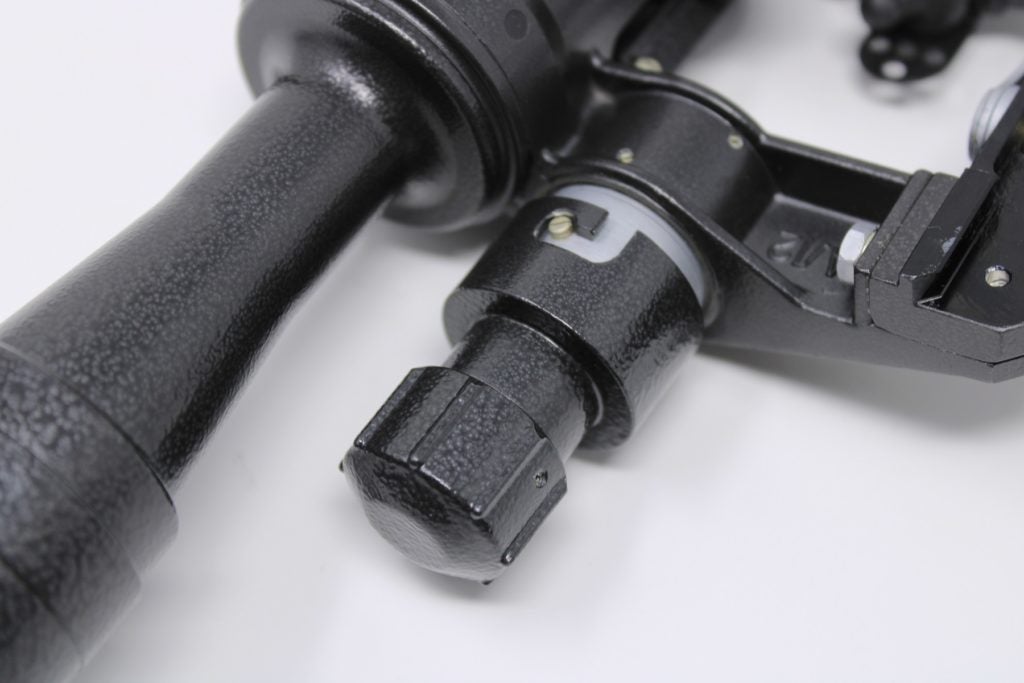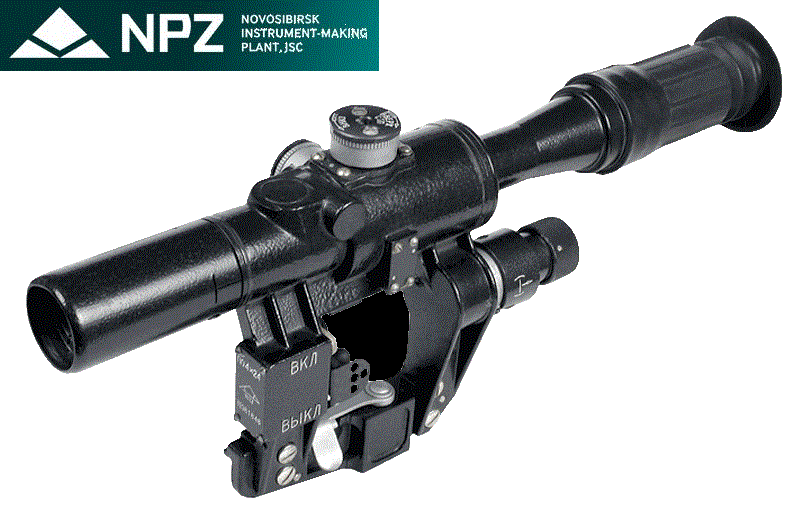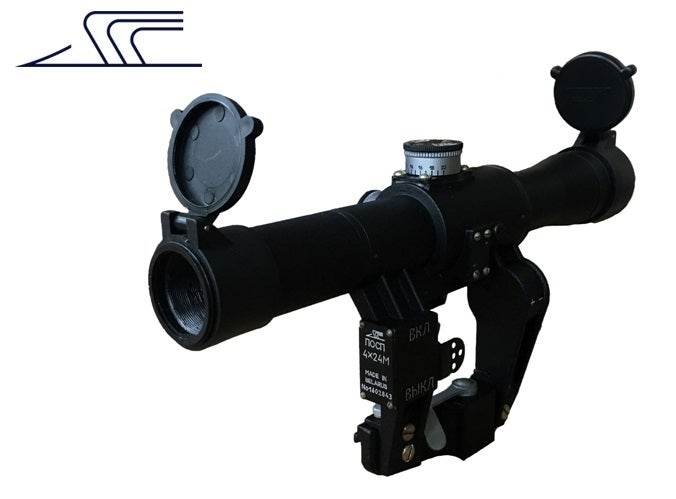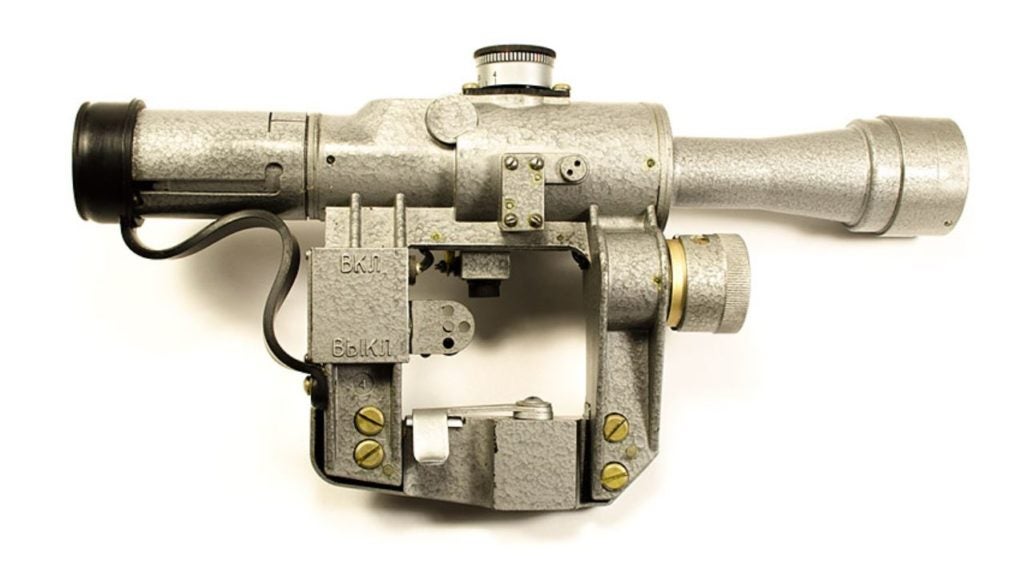AllOutdoor Review: The PSO-1 Rifle Scope History
Travis Olander 03.27.23
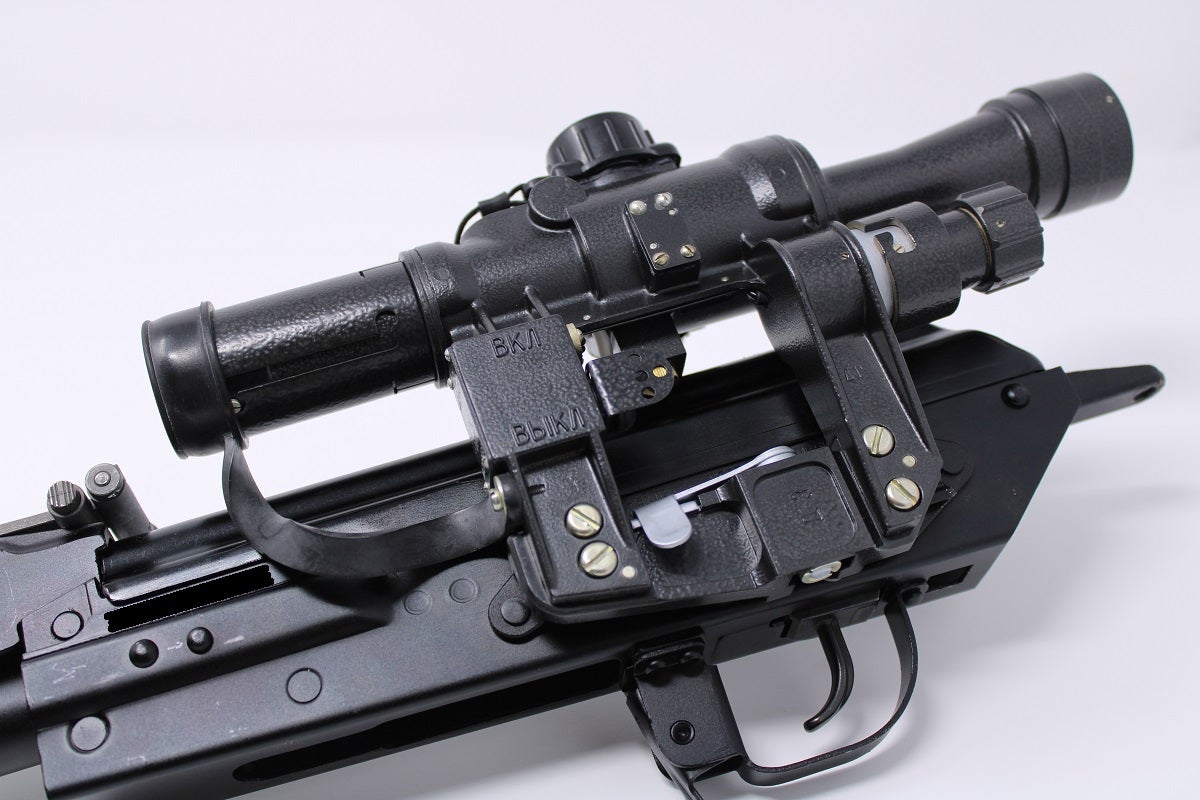
The PSO-1, Optical Sniper Sight, Pritsel Snaipersky Optichesky, or simply “Прицел Снайперский Оптический” is a 4×24 fixed-power telescopic sight designed for use on the Dragunov SVD, Tigr, NDM-86, and Romanian PSL family of rifles. It was hailed as one of the most technically advanced weapon sights ever designed in the ’60s and is still in service in the Russian Army today. We’ve been lucky to get our hands on a modern, Russian-produced PSO scope. Commercial variants of the PSO-1, known as the PO4x24 and POSP, are sold in the U.S. and Europe by two manufacturers, NPZ and Zenit-BelOMO. Let’s dive into the PSO’s specs, history, and functionality. We’ll get up close with an in-depth review, too.
PSO-1: Specs & Technical Data

PSO-1: Optical Specifications
- Magnification: 4x, fixed
- Objective Lens: 24mm
- Ocular Lens: 32mm
- Field of View: 6° (107 mils)
- Eye Relief: 2.68″ (68mm)
- Exit Pupil: 0.23″ (6mm)
- Resolution Limit: 12°/s (213 mils/s)
- Reticle: Stadiametric rangefinder
PSO-1: Physical Specifications
- Dimensions: 14.75″L x 2.76″W x 5.20″H (375 x 70 x 132mm)
- Body Material: Magnesium alloy
- Lens Material: Multi-coated glass
- Weight: 1.28 lbs (581g)
- Finish: Baked enamel
PSO-1: History, Features & Use

The PSO-1 was developed specifically for the SVD rifle chambered in 7.62x54r. The scope was introduced on July 3, 1963. It was originally manufactured by the Novosibirsk Instrument-Making Factory (“NPZ Optics State Plant”) and the Izhevsk Mechanical Plant. The PSO-1 and SVD rifle package was and still is deployed to Russian Army and Russian Special Operations elements as a Designated Marksman Rifle (DMR). A variant of the PSO scope was later developed for the 9x39mm cartridge and the integrally suppressed VS “Vintorez” and AS VAL rifles.

The PSO is now produced by NPZ in Russia and Zenit-BelOMO in Belarus for Kalinka, for both military and civilian use. The PSO-1 was designed to allow for rapid target acquisition by providing on-the-fly ballistic calculations, horizontal and vertical hold-overs, and distance-to-target estimations via a BDC rangefinding reticle. With a red-illumination function for low light and a light-blocking rubber eyepiece, the PSO-1 was also designed for use during low-light conditions and nighttime operations.
PSO-1: The “Simonov” Reticle and BDC Chevrons
The PSO-1’s infamous Simonov reticle is available with a 400m or 1,000m rangefinder and bullet-drop compensating (BDC) points of aim. The latter is most commonly found on PSO scopes, and it is designed to provide BDC for the 7.62x54r round and the SVD and PSL family of rifles. The 400-meter variant of the Simonov reticle is designed for the AK-47 family of rifles and the 7.62x39mm round. The Simonov reticle provides rangefinding capabilities by allowing the shooter to estimate the distance to any man-sized target with a height of 5’7″ or 1.7 meters. On civilian scopes, the rangefinder is instead sized up for estimating the distance to a 4’11” or 1.5-meter tall target.
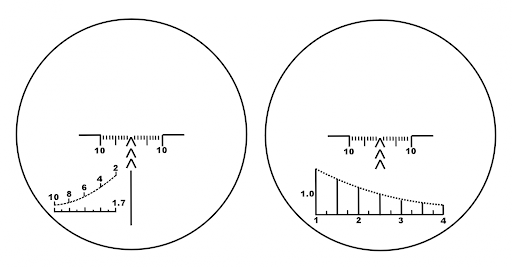
PSO-1: Range-Finding
The rangefinder works by placing the target within the portion of the reticle displaying distance tick marks. The target’s feet must be placed on the horizontal line and the top of the target’s head must touch the curved line. This example illustrates a target 5’7″ in height correctly ranged at a distance of 150 meters in the 400m variant of the PSO’s reticle:

PSO-1: Range-Finder Variances
This rangefinding reticle appears and functions for the same heights (1.7 meters for military-issue scopes and 1.5 meters for civilian scopes) on both 7.62×39 and 7.62x54r scopes. Some x39 scopes have been produced with a rangefinder estimating targets 1.0 meters (3’3″) tall. Distance estimations are not the same between the two variants. The x39 scopes estimate distance between 100 and 400 meters. The x54r scopes estimate distance between 200 and 1,000 meters. With a target’s distance estimated, the PSO’s reticle provides the shooter with bullet-drop compensating chevrons to act as quick-reference points of aim. In a firefight or while hunting, this negates the need to adjust for distance more slowly with the elevation turret. On x39 scopes, the first chevron is the default point of aim for targets up to 200 meters. The second and third chevrons compensate for bullet drop at 200 meters and 400 meters, respectively. On x54r scopes, the second, third, and fourth (not pictured above) chevrons compensate for drop at 1,100, 1,200 and 1,300 meters.
PSO-1: Windage Elevation & Hold-Overs
The Simonov’s horizontal scale is used to calculate and execute hold-overs, compensate for windage, and estimate distance. For the sake of hold-overs and windage, each tick mark on the scale is spaced 1 mil apart. Moving 1 mil left or right shifts point of impact by 4″ for every 100 meters. The distance between the tip of the first chevron and one-half of the scale measures 1 meter (3’3″) wide at 100 meters of distance:

Using the windage scale in this fashion, various distances can be recorded and referenced by spotting objects and reference points of a known size. This allows the shooter to quickly gauge targets’ distances as they appear, to employ the appropriate BDC chevrons and hold-overs as required. For the shooter who is experienced with his rifle and cartridge, the Simonov reticle provides intuitive aiming with nearly instant ballistic calculations.
PSO-1: Low-Light Illumination
The PSO’s internal illumination allows the reticle to be clearly viewed in low-light and nighttime conditions. Original scopes used a 2.5-volt bulb and Russian RTS-63 battery, a cell that is no longer made. For a time, a PSO-1C variant of the scope was made which included a resistor. The -1C allowed for the scope’s original 2.5v batteries to be used with the new 1.5v bulb, but this was phased out after the 1.5v bulb became the new standard. All PSOs and POSPs now use a 1.5v bulb and AA battery with an adapter that allows the original battery housing to accommodate the taller cell. Alternatively, a plastic spacer can be used on conjunction with two 1.5-volt Duracell D357 or D303 button-cell batteries to power a 3-volt LED bulb.
PSO-1: Discontinued IR Detection
The PSO-1 now issued to military units is designated the PSO-1M2, a modern version of the original scope in every way except one: The modern scope no longer comes equipped with an IR detection screen. The IR filter could, upon being charged by sunlight exposure for just 20 minutes, provide up to 48 hours of use. Via a switch, the IR detector screen would flip down in front of the reticle, giving the scope a green hue.
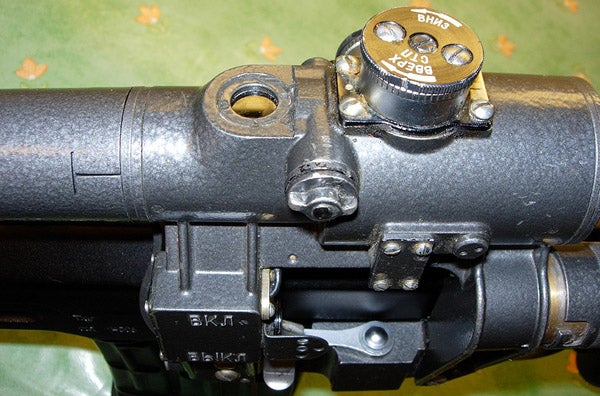
This screen allowed the shooter to visibly detect any enemy positions, vehicles, and fighters using night vision devices powered by IR illumination. Any infrared light would appear in the reticle as a bright glow. The feature became relatively useless in the 1970s once modern night vision systems began using internal light amplifiers instead of external IR bulbs to provide enhanced vision. According to sources in the Russian military, the IR feature was removed in 1992.
PSO-1: Lenses, Scope Material & Body
The SVD scope wasn’t just ahead of its time with IR detection and advanced reticles. Before the PSO’s debut, rifle scopes used brittle, un-coated glass and heavy steel or weak aluminum bodies. The PSO departed from this. It was the first scope designed to be abused like the rifle it sat upon. It was the first to use a lightweight yet strong alloy construction, made from magnesium and coated in a hard baked enamel finish. Magnesium alloys combine the lightweight and corrosion-resistant properties of aluminum with the incredible strength of titanium.
The scope’s reticle was ground and etched directly into a new type of multi-coated glass, too. The etched reticle ditched the need for thin, finicky reticle wires that could snap or loosen when rattled. The optics were all sealed and filled with nitrogen to prevent moisture from ever developing inside. The new lenses were more resistant to cracking and scratching, and they mitigated dust, water, reflections, and glare. The battery compartment was made low-profile and rugged, with a thick seal to keep water out. Heavy-gauge wiring was used and the illuminating module and (now-defunct) IR module were made easily serviceable. Compartments and mounts open with flathead screws and bolts. An integrated “Warsaw Pact” rail mount provides rigidity and additional strength for the scope’s body. In short, the PSO scope is the grandfather of the modern “battle-proof” glass optics produced by the likes of Trijicon, EOTech, and Aimpoint.
Fun Fact: Current-issue SVD rifles and their PSO-1M2 scopes are factory-matched, with each scope’s serial number engraved upon its rifle’s buttstock. Commercial Tigr rifles (a civilian variant of the SVD, made for hunting large game) and their scopes are also factory-matched; the Tigr’s serial number is instead engraved into the scope’s side mount to preserve the appearance of the rifle’s wood stock.
The Modern PSO-1 Review
We got ahold of an NPZ-made scope. Let’s get a closer look and see how this decades-old design holds up:
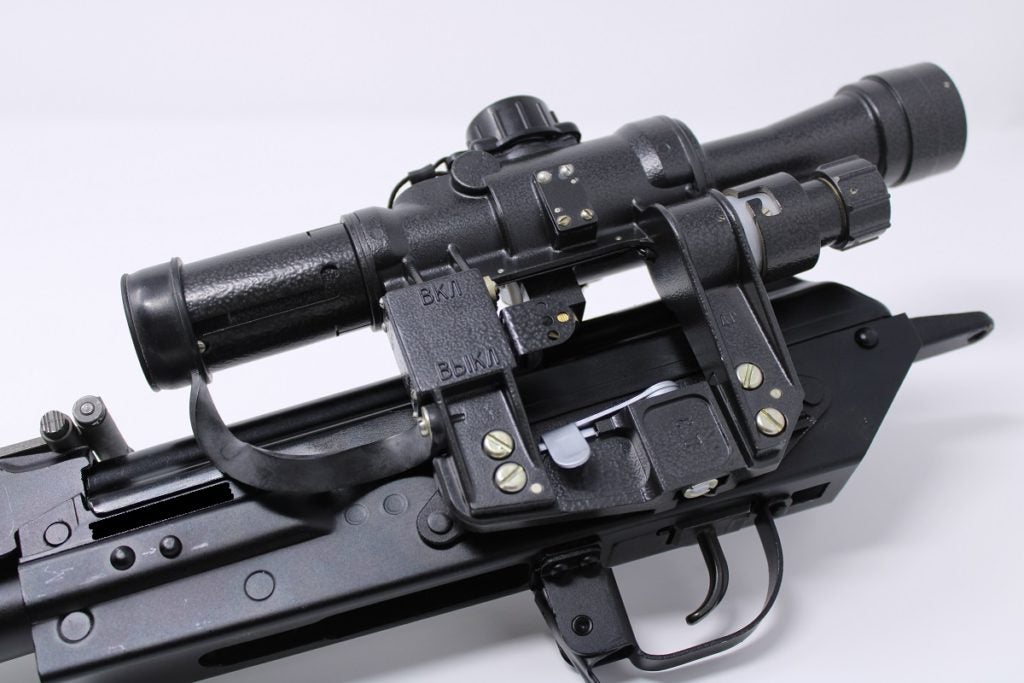
We picked up this commercial variant of the current military-issue PSO-1M2 to outfit a Molot VEPR undergoing an “SVD-ish” conversion (we’ll be covering that soon). We could’ve sprung for any other optic and a generic side rail mount, but the PSO’s reticle and its profile and quality continue to impress. Plus, it affords a classic look and is recognizable by almost any gun enthusiast.
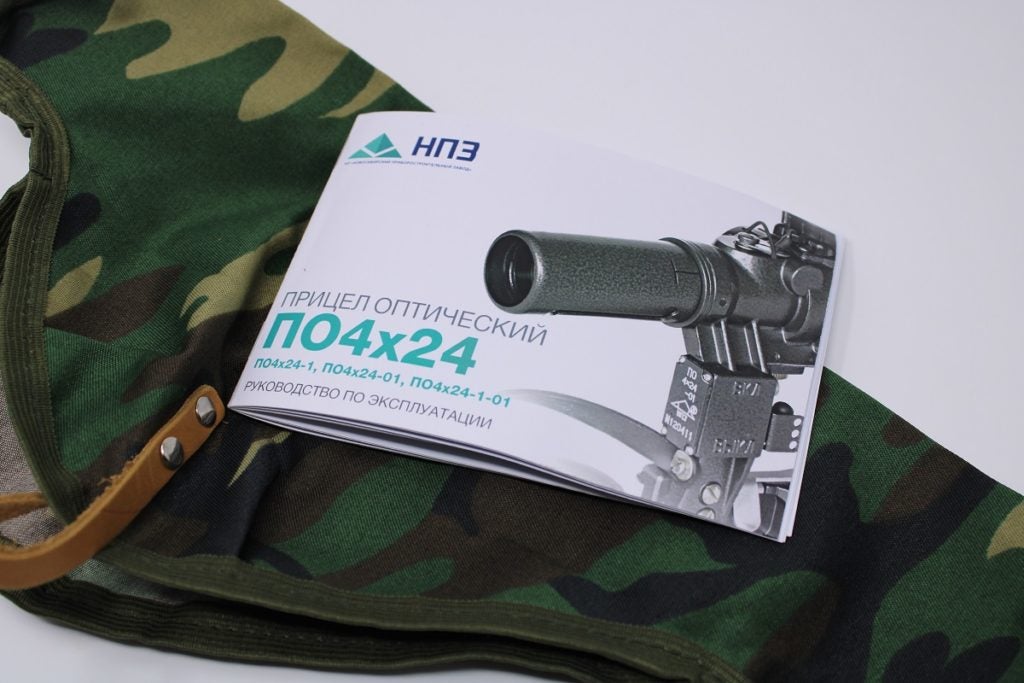
Unboxed, the PSO comes with documentation from NPZ officially identifying it as a PO4x24. The scope’s booklet is entire Cyrillic, with no English translation. A digital manual in English can be downloaded. The PO4x24 model name is the commercial designation for the PSO-1M2. Although different in name and rangefinder target height, this scope is functionally and materially the same as a current military-issued scope. The optic comes with a camouflage-patterned canvas cover, which secures over the scope with a leather strap when not in use.
PSO-1: Using an SVD Mount on AK Rail
If you’re purchasing a PSO scope to outfit your PSL, VEPR, or other AK build, it’s important to note the clearance (or lack thereof) between the reticle illumination module and the receiver’s dust cover if using a PSO with an SVD mount instead of an AK mount:
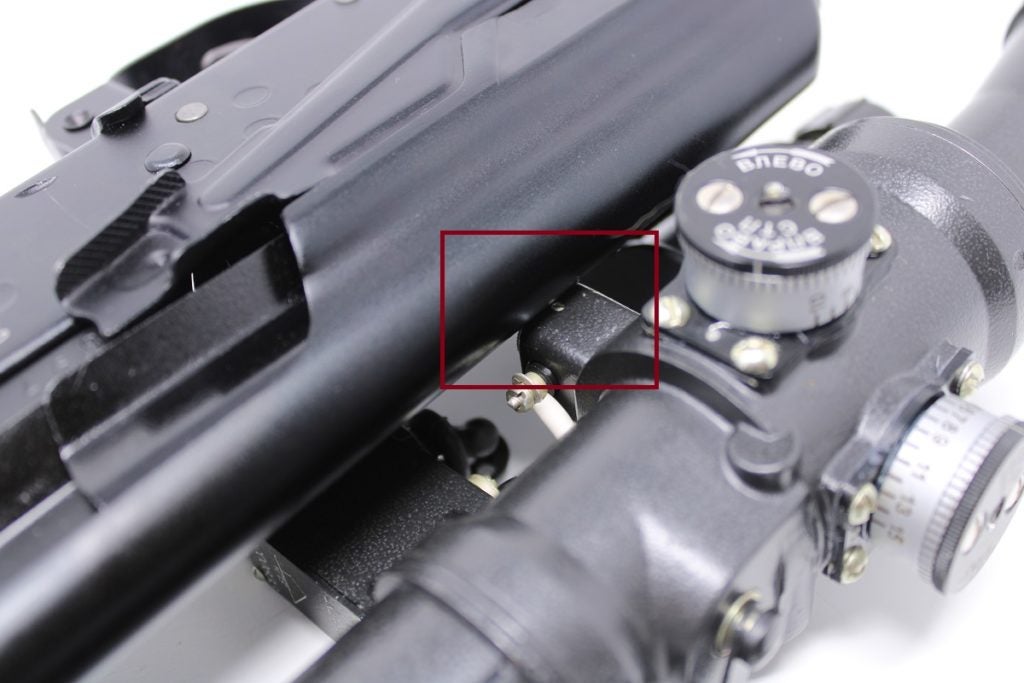
The bottom of the module may just barely contact the dust cover on the VEPR’s or PSL’s receiver. There is no pressure being applied to the scope body and neither the scope nor the dust cover is at risk of being damaged when fired, but the following should be considered by any PSL or VEPR owner investing in a PSO scope: It is preferable to use the SVD-type mount on these two AK-type rifles because the SVD mount’s position provides more appropriate placement of the scope relative to the shooter and buttstock. But this mount also reduces the height of the scope, bringing it closer to the receiver. The scope pictured below is a BelOMO POSP, another commercial variant of the PSO-1 that we’ll discuss later. This variant shows the AK-type mount. It provides higher and more forward placement of the scope relative to the receiver.
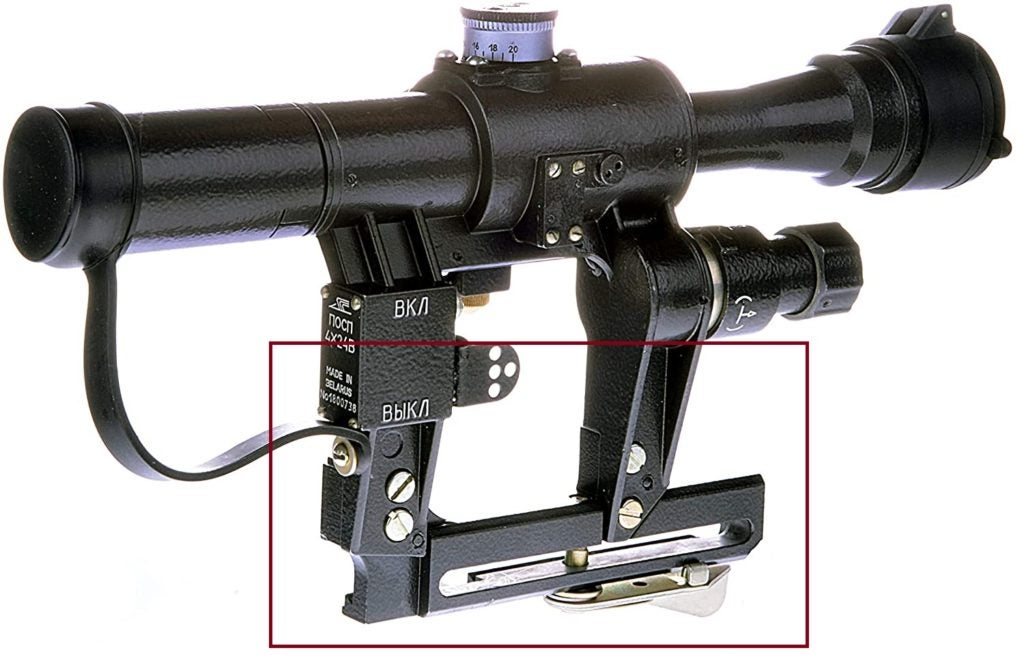
Both types of mounts utilize the same adjustable tension latch and steel guide pins to seat and secure the scope to the receiver’s rail mount.
The inside of the rail mount is well-constructed: All pins and fasteners are recessed inside the magnesium alloy, and the tension spring for the latch is captured by a recessed pin made from a coated metal. NPZ also greased the inside of the mount, and the baked enamel finish is just as present and well-cured inside this area to prevent any corrosion. The hex-head bolts securing the mount’s base to the scope are seated with small washers; one bolt appears spot-welded.
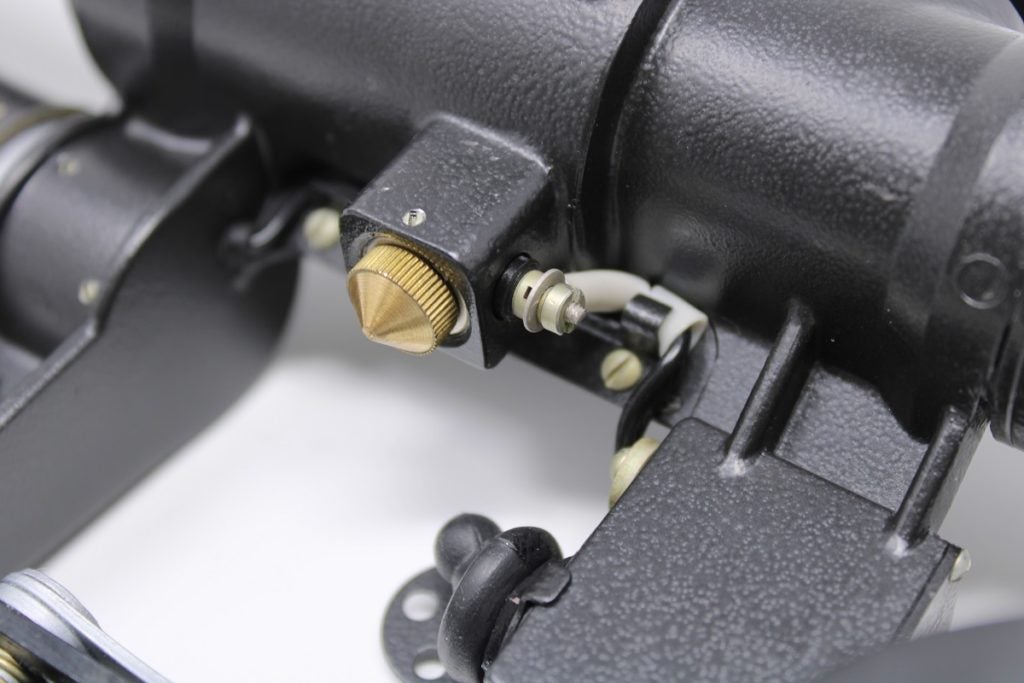
Above, the red illuminator module is shown with a brass knurled fixture for removing and replacing the 1.5v red bulb inside. The wires providing power and ground are double-sleeved, thick gauge, and use a flathead fastener to secure to the terminal. It’s a well-built and easy-to-service design.
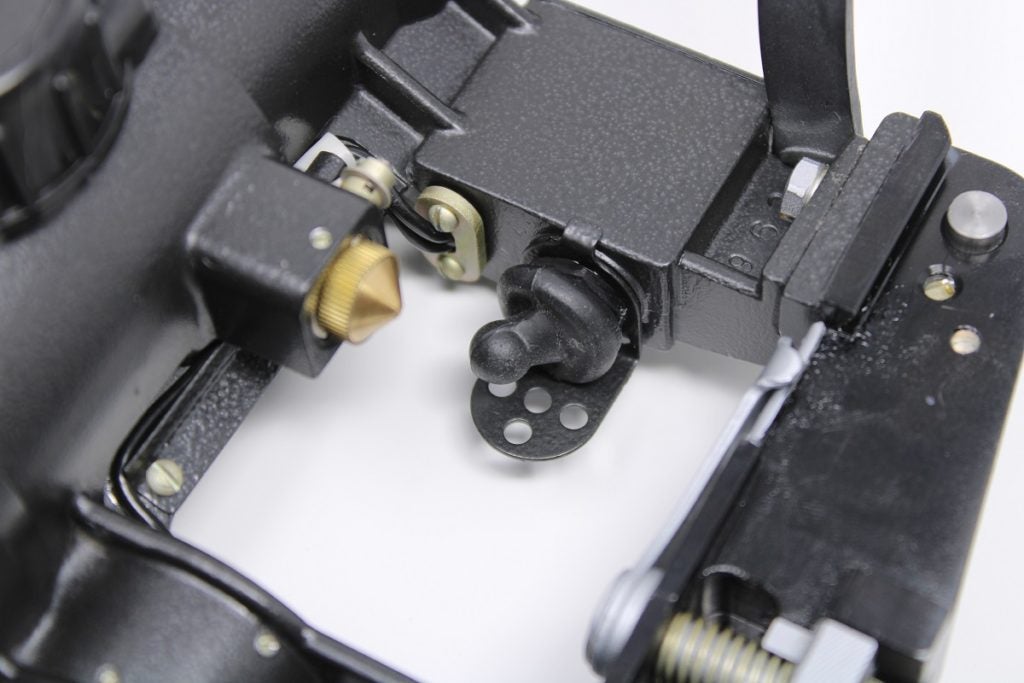
Attached to the inside front leg of the scope mount is the rubber-booted toggle switch to turn illumination on and off. A small metal guard is fitted to the base of the switch and rubber boot with a thin hex-head bolt. The back of the guard sports a small tab to prevent it from wiggling loose or rotating. Also shown is a small metal fitting secured by two flathead bolts which secures the illuminator’s wires to the inside of the scope mount. Every sensitive component on this scope sports layers of protection, a type of redundancy made (and extra weight) feasible by the lightweight magnesium body.
Providing power to the scope, surprisingly, is a simple AA battery. The housing’s cap is held in place with a brass pin and a thick compressible O-ring inside provides tension to keep the cap and battery secure, and free of dust and water.
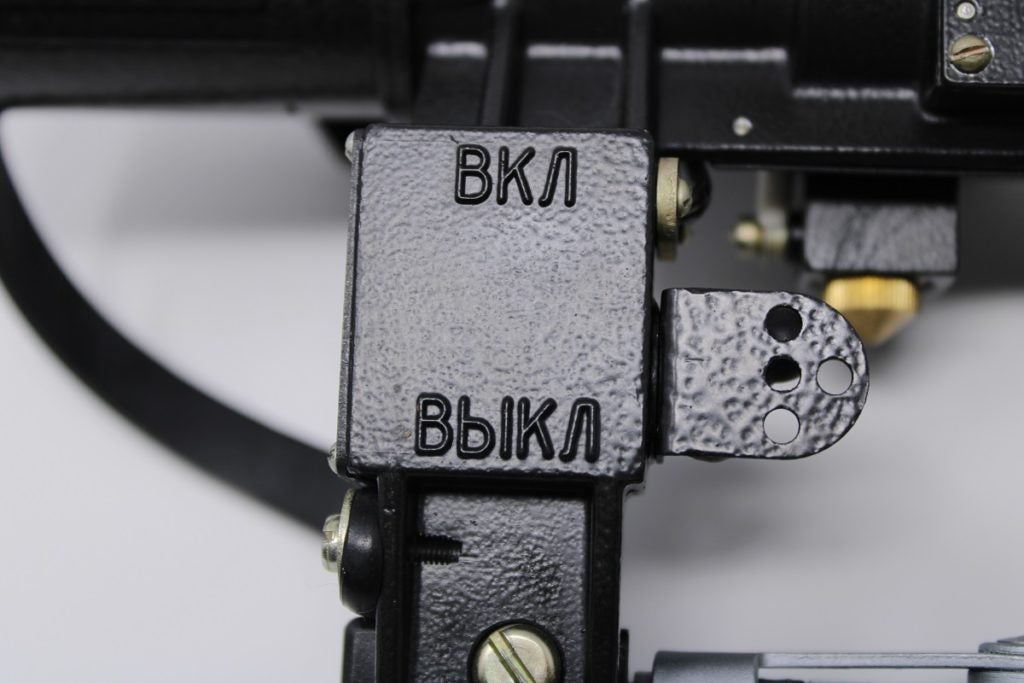
The front side of the toggle switch housing displays “ON” and “OFF” in Cyrillic for the switch’s function. This shot also shows off just how thick the cured enamel coating is on the scope’s body, especially on the switch guard.
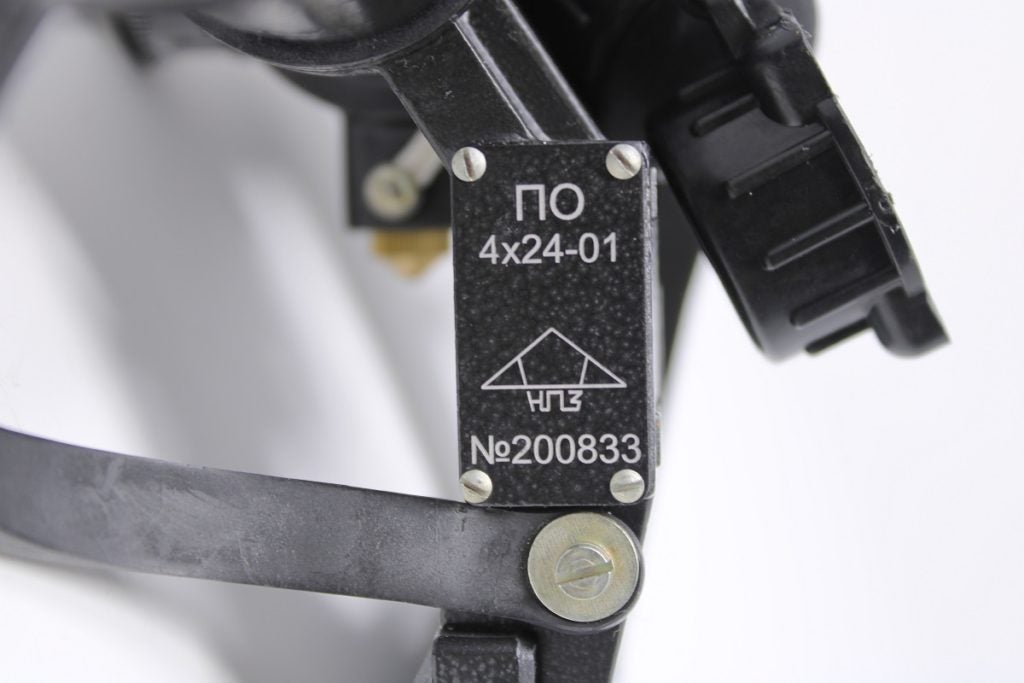
The outside of the front leg sports a bolted cover for the toggle switch housing. Regardless of manufacturer or variant, all PSO scopes will typically display the scope’s model name, serial number, and maker’s mark here. For NPZ’s modern PSO, it is “PO4x24-01”.
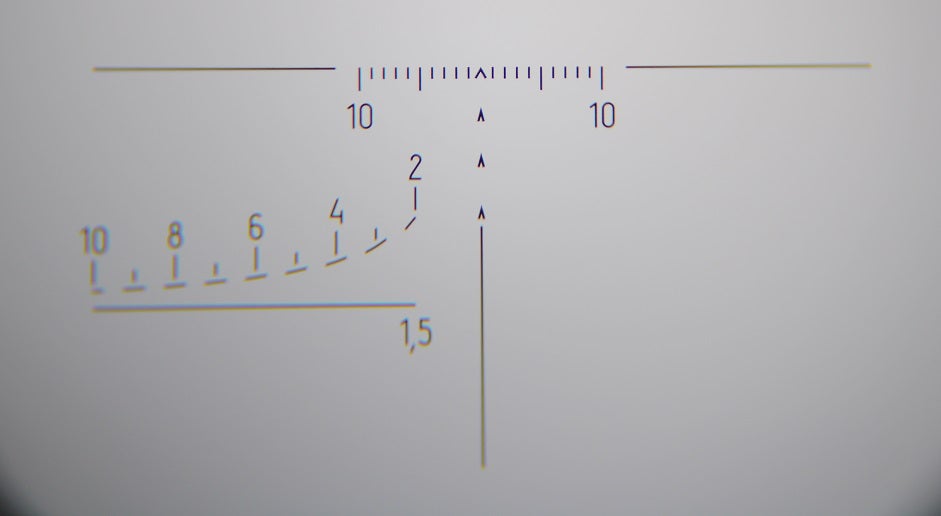
Difficult to capture with a camera lens, the Simonov reticle appears crisp and clear as it rests etched into the optic’s glass. Just faintly visible is a blue hue toward the center of the reticle, with green hues toward the edges. This is evidence of the coatings present on the optic’s lenses, which can cause subtle color changes when viewed against a bright white background.

Even more difficult to capture with a stable shot, the red illumination works very well in low-light conditions. No light bleed or glare was observed. The reticle fills out in clearly defined markings when lit. The blur seen around the numbers and tick marks is not present; an unfortunate side-effect of using long exposure to capture the image.
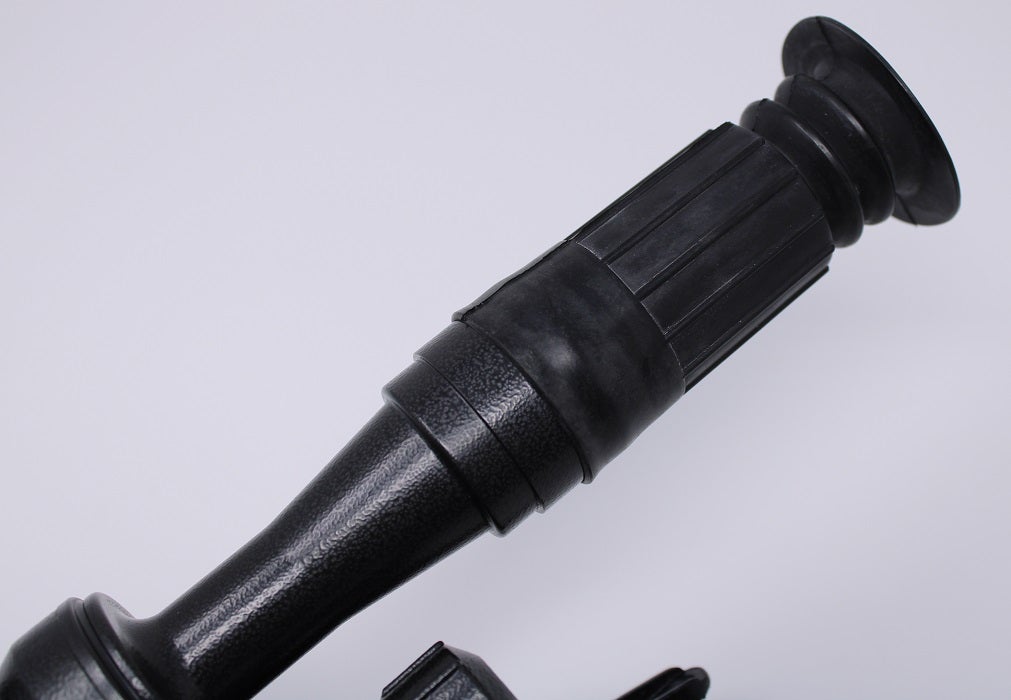
Helping capture the illuminated reticle in low light is the iconic rubber eyepiece. This simple scope hood hasn’t changed in material or design since 1963 and provides a simple but effective way to block light pollution when shooting in dark conditions. It also helps to provide appropriate eye relief for a consistent sight picture.
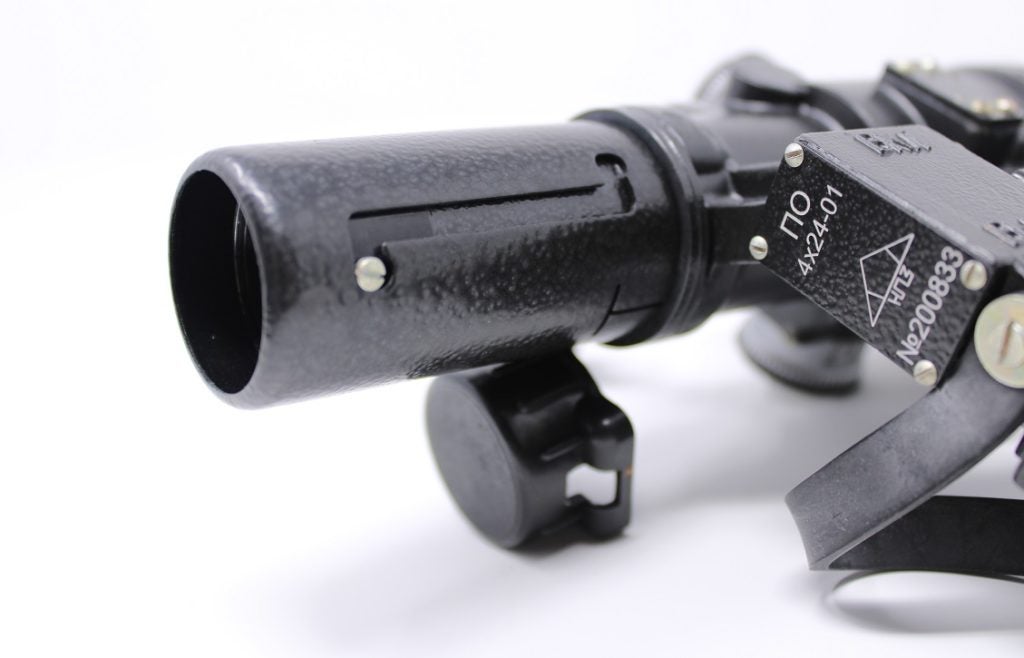
Up front, a retractable sunshade is built into the front of the scope body. It can be extended or retracted via a small pin and slot cut into the shade. The shade also provides an extra layer of protection for the front lens.
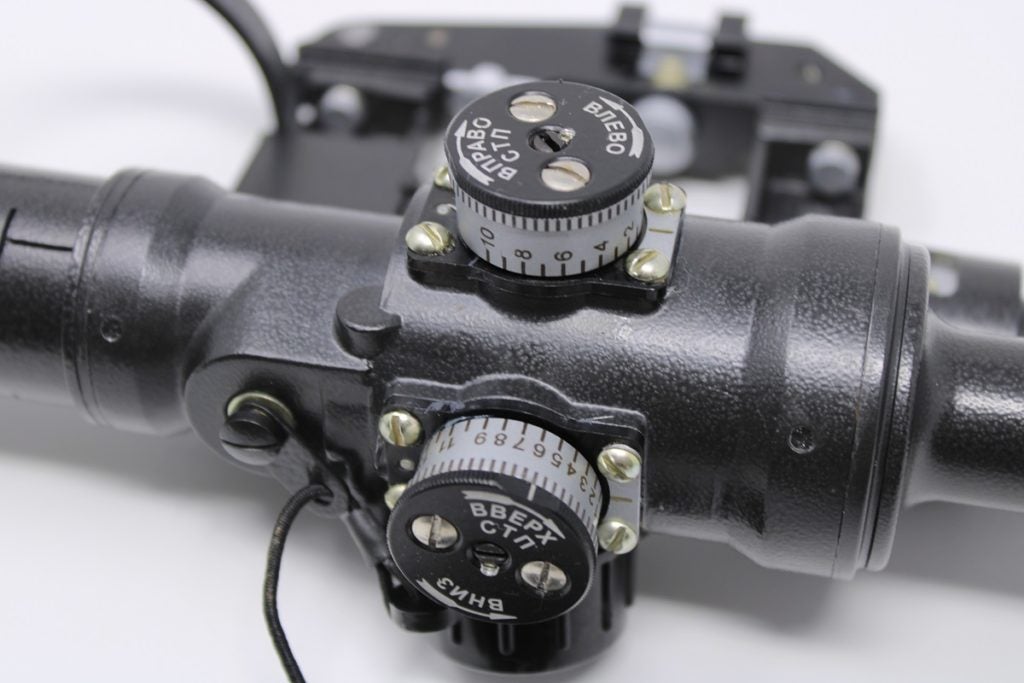
The turrets on the modern PSO-1 and POSP 4×24 scopes provide the same function as they did in 1963: The windage and elevation turret each provides 0.5-mil adjustments (5cm or 2″) at 100 meters. The elevation turret also features bullet drop compensation. For x54r scopes, BDC adjustments are made in 50- or 100-meter increments when shooting between 100 and 1,000 meters.
Available Variants of the PSO-1
NPZ Series (Commercial)
Model Name: PO4x24
NPZ is the original manufacturer of the PSO-1 and the current PSO-1M2. If you want your scope to be as close to an original military unit as possible, the PO4x24 or 4×24-1 is the scope to purchase. It is only different from the current-issue military optic in that its rangefinder uses a target height of 1.5 meters instead of 1.7 meters. Russian law prohibits the export of equipment and weaponry currently in use by its armed forces to the United States. The use of a different rangefinder height and model names allow NPZ to say this scope is not technically a PSO-1M2, which allows for its legal sale and export.
Where to buy
NPZ doesn’t maintain a large presence outside Russia. Locating and purchasing an NPZ scope will most likely require you to order from overseas vendors. We procured our NPZ scope from a reseller called Ivan Tactical while they still had units in stock. NPZ scopes are occasionally available for purchase and shipment to the U.S., though they’re hard to come by. Shipment from Russia to the US takes approximately 14 to 21 days.
Zenit-BelOMO Series (Commercial)
Model Name: POSP
Zenit-BelOMO is another original manufacturer of the PSO. Because they make their commercial POSP scope exactly like their military PSO-1 scopes of decades past, they’re also a top choice for getting your hands on a perfect clone. Unlike NPZ, BelOMO makes PSO variants (all dubbed the “POSP”) that come with features like higher magnification, adjustable zoom, and different rail attachments for the AK’s numerous optic mounts. Since the POSP is manufactured in Belarus, its scopes are not subject to Russian export restrictions like NPZ scopes. You can therefore purchase a POSP configured with the historically correct 1.7-meter rangefinder. The POSP can also be purchased with a 1.8-meter (5’11”) rangefinder, which some say is more appropriate if engaging a man-size target. Lastly, POSP scopes use a compact 3-volt battery and bulb, adhering to the PSO’s original design more authentically than modern variants using 1.5v hardware.
Where to Buy
Unlike NPZ, BelOMO fulfills orders internationally via Amazon, making purchase by a US buyer much easier. You can get the original SVD-type POSP 4×24 with 1,000m rangefinder here, dubbed the 4x24M. If you’re installing your scope on a PSL or VEPR and prefer having the scope rest higher on the receiver, you can opt for a POSP with an AK mount and 1,000m rangefinder, called the 4x24VM. Rifles and standard AKs chambered in 7.62×39 should be fixed with a 400m rangefinder variant, called the 4x24V. Shipment from Belarus to the US takes approximately 14 to 21 days.
Military Surplus
Model Names: PSO-1, PSO-1C, PSO-1M2
If you just have to have the real thing, you can still find military-issued surplus PSO-1s available for private sale and auction. These scopes are hard to come by and could be missing their rubber eyepiece, scope caps, or sunshade. They may also have non-functioning illuminators. For collector value, locating an older PSO with the IR detector will command a higher price. Older scopes with the lighter silver enamel finish also tend to command high prices.
Where to Buy
Because rifle scopes aren’t considered firearms, they can be bought and sold through almost any auction site. Popular sites like eBay, Gunbroker, and Armslist are the best places to start your hunt. You should also consider visiting popular firearm forums like The AK Forum, AK Files, Sniper’s Hide, and VEPR.org. These communities maintain boards for advertising the sale of private and preowned AK parts and Eastern Bloc military gear, and scopes are occasionally posted for sale by community members.
